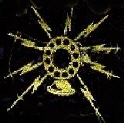
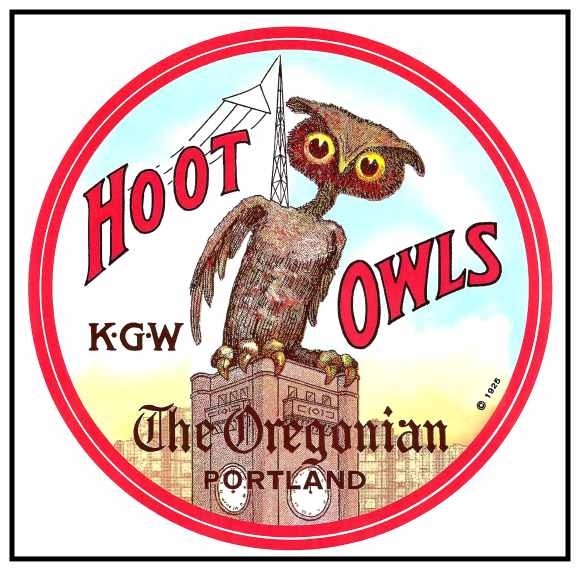
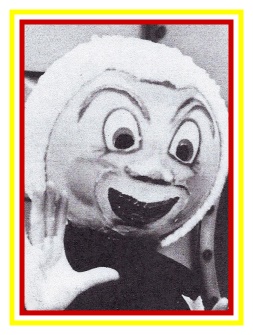


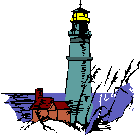
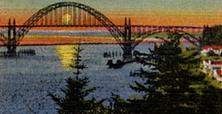

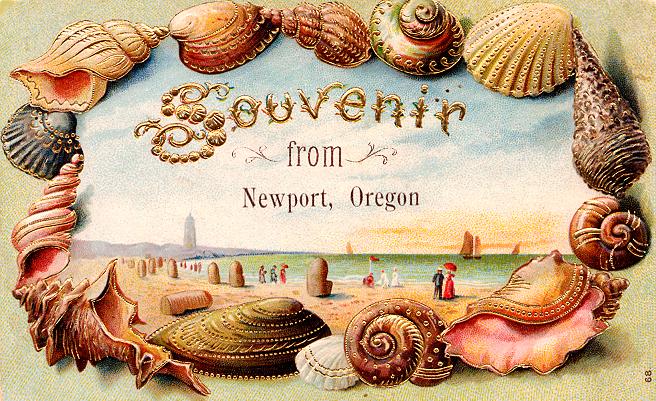

Newport is the largest town on the Central Oregon Coast, between Astoria in the north to Coos Bay in the south. The nation’s growing appetite for oysters led to the growth and development of Newport.
 |
 |
 |
 |
||||||||||||||||||||||||||||
 |
|||||||||||||||||||||||||||||||
 |
|||||||||||||||||||||||||||||||
 |
|||||||||||||||||||||||||||||||
|
|
|||||||||||||||||||||||||||||||
 |
|||||||||||||||||||||||||||||||
 |
|||||||||||||||||||||||||||||||
 |
|||||||||||||||||||||||||||||||
|
Newport is the largest town on the Central Oregon Coast, between Astoria in the north to Coos Bay in the south. The nation’s growing appetite for oysters led to the growth and development of Newport. |
|||||||||||||||||||||||||||||||
|
|
Newport, Oregon is located where the Yaquina Bay and River meet the Pacific Ocean and it is a town that is rich in history |
|
As early as 1856, Yaquina Bay was visited by the sailing vessel Calumet, laden with supplies for Lieutenant Phil Sheridan and the nearby military garrison. When the Yaquina Bay oyster beds were discovered in 1862, great profits were made by exporting the delicacy to San Francisco and elsewhere. Settlers from the East Coast began homesteading in the Yaquina Bay area in 1864. |
|
|
Early settlers told of a great celebration of 400 persons gathered at Newport on the Fourth of July in 1866. They met at Newport, a small lumbering and fishing village on the north shore of the Yaquina Bay to celebrate the 90th Anniversary of American Freedom. Local tribesmen numbering three hundred came to Newport to see the Boston Men raise the American Flag for the Fourth of July Celebration which started with prayers. The prayers were followed by eloquent speeches that admonished everyone to love God and country. After the ceremonies, everyone partook of a huge feast and in their merriment; someone suggested that the new town become “the San Francisco of Oregon”. Easterner Sam Case from Maine moved to the Central Oregon Coast and with the help of partner J.R. Bayley, they built the Ocean House to accommodate the growing influx of visitors to Newport in 1866. It was the first building in Newport and it was named after a grandiose hotel in Newport, Rhode Island. Sam Case built a cottage nearby on the corner of Naterlin Drive and in later years it was known as Ida Ingalls’ home. Newport’s first Post Office was established on July 2,1868 and Sam Case was the first postmaster. |
|
|
Early view of Newport’s Waterfront before the Bridge was built |
|
|
Newport’s Lifesaving Station and Crew |
|
Newport’s first Lighthouse was built on the northwest side of the Yaquina Bay to assist ships and boats in safe navigation during stormy or foggy weather in 1871. It served for three years until a new Lighthouse was built at Yaquina Head, three and a half miles to the north in 1873. Yaquina Head is on a narrow finger of land that eventually goes down into the sea. There were about six buildings and a large fenced garden for the caretakers. It is one of five Lighthouses still operating in Oregon. Legend has it how the materials were delivered in error, two and a half miles south from the planned location at Cape Fowlweather, which is on a cliff 500 feet above the sea. |
|
|
|
|
Newport is home to two lighthouses. There is the famous Haunted Yaquina Bay Light House at the north end of the bridge. When they were on duty, the Lifesaving Crew stayed in the Yaquina Bay Light House. |
|
|
The Yaquina Head Lighthouse, which is one of five lighthouses still operating in Oregon, guards the north end of Newport. |
|
In 1875, Case summoned his nephew Alonzo Case, who was 31 years old, to come west. Alonzo established a General Store on the Waterfront and sent for his family after he was settled. In the spring of 1882, the Schwaibold Yaquina Brewery opened. In a short time, it was supplying five saloons with beers and ales. That same year, on November 1, Newport was incorporated as a city and Alonzo Case was elected as the first Council President (Mayor) of Newport. |
|
|
The Hotel Abbey was one of Newport’s most prestigious hotels for honeymooners and visitors alike and it opened in 1911. Mr. Abbey was very proud of the six lightening rods that were attached to the roof of the Abbey. |
|
|
Mrs. Abbey prided herself in setting a fine table and offering superb service in her beautiful Dining Room |
|
The Abbey Hotel underwent many changes over the years and it passed from one owner to the next. The Hotel burned to the ground in an early morning fire on Mother’s Day, May 10, 1964. |
|
|
With over $1 million dollars in federal money out of the $5 million allotted from President Roosevelt’s Works Progress Administration for five bridges on the Oregon Coast in the 1930’s, the Yaquina Bay Bridge was opened on October 3, 1936. The nation was in the midst of the Great Depression and these jobs helped put the country back to work. |
|
|
The Yaquina Bay Bridge is 38 and ½ feet wide and 6 tenths of a mile long, with a main span of 600 feet. Conde B. McCullough designed all of the bridges in this project. |
 |
|||
|
|
Lafe & Suzie Lewis ride in a new-fangled aeroplane over Nye Beach. You can see the Yaquina Head Light House in the distance to the left and Jump-off Joe on the far right. This view is from August 1911. |
|
|
Early view of Nye Beach |
|
|
Nye Beach was a popular playground and planes would frequently land on the beach |
|
|
Construction began on the Cliff House in 1910 and it was completed in 1913. This view is from 1916. |
|
|
This view shows the same people and the same car that is in the previous view from 1916. |
|
|
Lobby of the New Cliff House in Nye Beach |
|
|
Peter Gilmore purchased The Cliff House in 1921 and changed the name to the Gilmore Hotel. Many a couple spent their honeymoon at the Gilmore. It is now the Sylvia Beach Hotel. Wood planks covered the streets. |
|
In the mid-1980’s, Sally Ford, of the Roseburg Lumber Company family, teamed with Goody Cable (of the Rimsky-Korsakoffee House in Portland) to buy the rundown hotel and they began the difficult task of renovation. They renamed it the Sylvia Beach Hotel. Each of the 20 guest rooms was decorated differently, and each was made up to look like a particular author’s room. The rooms are named for Edgar Allan Poe, Herman Melville, Robert Louis Stevenson, Tennessee Williams, Mark Twain, Agatha Christie, Ernest Hemmingway, Willa Cather and Oscar Wilde, among others. |
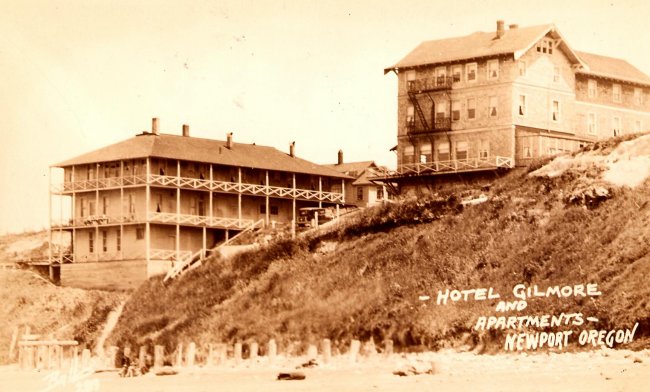 |
|||
|
In 1928 Peter Gilmore purchased Dr. Minthorn’s Sea Baths and renamed them the Gilmore Apartments as seen to the left in this view |
|||
|
Many people are familiar with Newport’s Bayfront with its fishing boats and eclectic little shops (including the Undersea Gardens, the Wax Museum and a Ripleys Believe It or Not Museum), but many people are not aware that Newport has several ocean beaches. Probably, the nicest beach is at the Nye Beach Turnaround (near the Sylvia Beach Hotel). |
|
|
This view shows the Restrooms, which are now a gallery, as well as Dr. Minthorn’s Hot Sea Bath House which was built in 1902 |
|
|
View from the Restroom toward the beach. |
|
|
The Natatorium is on the left and the Rest Rooms are on the right. A sign on the Rest Room says “Baggage Checked” and “Lunches”. |
|
|
This view shows the original Nye Beach Natatorium which was built in 1911. It burned to the ground on January 16, 1922. |
|
|
Early view of the Nat (Natatorium) in Nye Beach. |
|
|
Interior view of the Nat at Nye Beach. |
|
After the Nat burned in 1922, a new Natatorium with a domed roof was built and it housed a swimming pool and dance hall. In later years, it housed boxing matches, a bowling alley and a movie theater; you could also play miniature golf. Eventually, the Nat fell into disrepair and it is no longer there. Today, there is a parking lot at the turnaround where the NAT stood. Nye Beach also became a summer literary center for the study of the sciences, especially geology, biology and botany. |
|
|
The Nicolai Hotel was built in 1912, just north of the Nat. It had a large dining room and grand ballroom. Governor West attended the grand opening and watched horse racing from the veranda. |
|
|
Early view of the Lobby of the Nicolai Hotel. The name of the Hotel changed in the mid-1920s to the Ocean View House. Dwindling finances led to its demise and the building was torn down in 1930. |
|
|
Nye Beach as it looked about 85 years ago. The Cozy Corner Grocery to the left is gone today. Also gone is the Natatorium, which has the arched roof to the center and to the right. |
|
Nye Beach has been drawing people to the beach for well over 100 years. In early days, cottages were built where the women and children would spend the summers and the men of the families would join them for the weekend after spending long days working in the forests and sawmills. In 1891, a boardwalk was built to connect Nye Creek with the Newport Bayfront. Two years later, it was replaced with a road. Summer college classes were held in a specially-built auditorium. In 1902, Dr. Minthorn (uncle of President Herbert Hoover) built a sanitarium east of what is now the Sylvia Beach Hotel. There were hot seawater baths with small dressing rooms. When his mother died, Hoover went to live with Dr. Minthorn until going away to college at Stanford. Today, Nye Beach, as well as the Sylvia Beach Hotel, attract hundreds of book-loving tourists each year, who seek solace in the peace and tranquility that have attracted people to the area for so long. |
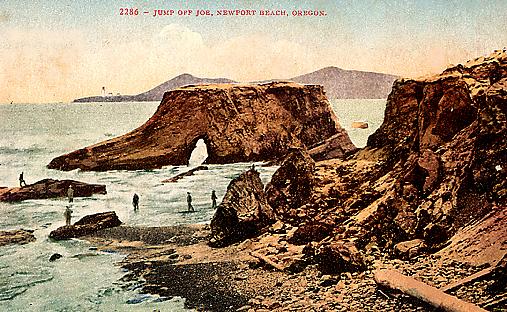 |
|
For many years Jump Off Joe was a well-known landmark. Very little of these rocks remain today. Legend has it that an Indian named Joe was cornered on the rock and rather than be captured, he jumped to his death into the Pacific Ocean. |
|
|
Early view of Toledo in 1910 |
|
My dad grew up in Toledo, which is seven miles up the Yaquina River from Newport. He and his family had moved there from Colorado in 1925, when he was two years old. There was the lure of decent paying jobs for anyone willing to endure hard work in the Lumber Mills. During World War I, Toledo was home to the largest spruce mill in the world and the wood for Howard Hughes’ Spruce Goose came from this mill. |
|
|
||||||||||||||||||||||||
|
Last updated 10-26-16 |
|
copyright © 2017 PdxHistory.com |